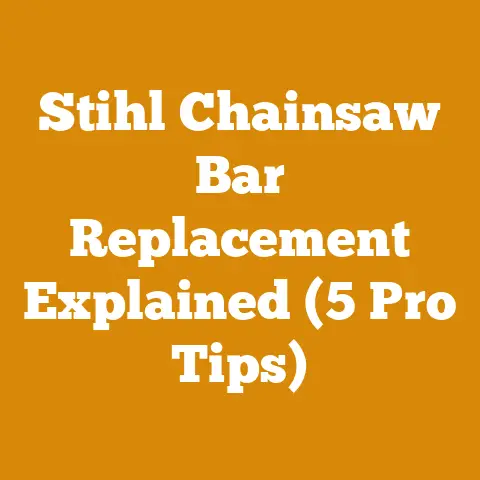Stihl Bar Nuts Explained (5 Key Specs Every Logger Must Know)
I’ll never forget the day I almost lost a bar on my Stihl MS 261. I was deep in the woods, felling a good-sized oak, when I noticed something wasn’t quite right. The chain felt loose, and there was an unusual vibration. I stopped immediately, and that’s when I saw it: one of the bar nuts was gone, and the other was hanging on by a thread. Had I continued, I could have seriously damaged my saw or, worse, injured myself. That day, I learned a crucial lesson about the importance of those seemingly insignificant little pieces of hardware – the bar nuts. So, let’s dive deep into the world of Stihl bar nuts.
Stihl Bar Nuts Explained: 5 Key Specs Every Logger Must Know
Why Bar Nuts Matter: More Than Just Tightening
Bar nuts are fundamental to the safe and efficient operation of your chainsaw. They aren’t just there to hold the bar in place. They ensure proper chain tension, prevent bar slippage, and contribute to the overall stability of the cutting system. A loose or incorrect bar nut can lead to a cascade of problems, from premature wear on the chain and bar to potentially dangerous kickback situations.
Understanding the Anatomy of a Stihl Bar Nut
Before we delve into the specifics, let’s break down the anatomy of a typical Stihl bar nut.
- Thread Size and Pitch: The thread size and pitch are critical. Using the wrong size will either not fit or, worse, strip the threads on the bar studs.
- Nut Diameter: The outer diameter of the nut must match the recess in the chain cover.
- Nut Height: The height of the nut affects how much of the stud it engages. Insufficient engagement can lead to loosening under vibration.
- Material: Stihl bar nuts are typically made from hardened steel to withstand the high stresses and vibrations of chainsaw operation.
- Locking Mechanism: Some bar nuts feature a locking mechanism, like a nylon insert or deformed threads, to prevent loosening.
Spec 1: Thread Size and Pitch – The Foundation of Compatibility
Thread size and pitch are the most critical specifications. Stihl uses metric threads, and the most common sizes are M8 and M10. The pitch refers to the distance between threads. For example, an M8x1.25 nut has an 8mm diameter and a 1.25mm thread pitch.
Why it matters: Using the wrong thread size will damage the bar studs or the nut itself.
How to identify: You can usually find the thread size and pitch listed in your chainsaw’s manual or stamped on the original nut. Thread gauges are also available for accurate measurement.
My experience: I once tried to use a generic M8 nut on my Stihl MS 170, thinking all M8 nuts were created equal. The nut went on but felt loose, and after a few cuts, it stripped the threads on the stud. I had to replace the entire stud, a time-consuming and frustrating experience.
Actionable Tip: Always consult your chainsaw’s manual or a reputable parts dealer to confirm the correct thread size and pitch for your model.
Spec 2: Nut Diameter – Ensuring a Proper Fit
The nut diameter must match the recess in the chain cover. If the nut is too large, it won’t seat properly. If it’s too small, it may not provide adequate clamping force.
Why it matters: An improperly sized nut can lead to uneven clamping pressure, causing the bar to shift or the chain to loosen.
How to measure: Use a caliper to measure the outer diameter of the nut. Compare this measurement to the diameter of the recess in your chain cover.
Real-world example: I’ve seen loggers use washers to compensate for a nut that was slightly too small in diameter. While this might seem like a quick fix, it’s not ideal. Washers can compress or deform under pressure, leading to inconsistent clamping force.
Best Practice: Always use a nut with the correct diameter for your chainsaw model. Avoid using washers as a substitute.
Spec 3: Nut Height – Maximizing Stud Engagement
The height of the nut affects how much of the stud it engages. Insufficient engagement can lead to loosening under vibration, especially with high-powered saws.
Why it matters: Adequate stud engagement ensures that the nut can withstand the forces generated during cutting.
How to determine: A general rule of thumb is that the nut should engage at least the same number of threads as the stud’s diameter. For example, an M8 stud should have at least 8 threads engaged by the nut.
Case study: A logging company I consulted with was experiencing frequent bar slippage on their Stihl MS 462 chainsaws. After investigating, we found that they were using aftermarket bar nuts that were slightly shorter than the OEM nuts. Replacing the nuts with the correct height resolved the issue.
Pro Tip: If you’re unsure about the correct nut height, compare it to the original nut or consult your chainsaw’s parts diagram.
Spec 4: Material – Hardened Steel for Durability
Stihl bar nuts are typically made from hardened steel to withstand the high stresses and vibrations of chainsaw operation. The material’s hardness and tensile strength are critical for preventing deformation and failure.
Why it matters: A weak or improperly hardened nut can strip its threads or even break under load.
How to identify: Look for markings on the nut indicating its material grade. Stihl nuts typically have a high-strength steel designation.
My experience: I once purchased a set of inexpensive, generic bar nuts online. They looked similar to the OEM nuts but were noticeably lighter. After only a few hours of use, one of the nuts deformed, making it difficult to remove. I learned my lesson about the importance of using high-quality, hardened steel nuts.
Value Added Tip: Always purchase bar nuts from reputable suppliers that can guarantee the material’s quality and hardness.
Spec 5: Locking Mechanism – Preventing Loosening
Some Stihl bar nuts feature a locking mechanism, like a nylon insert (nylock nut) or deformed threads, to prevent loosening under vibration. These mechanisms create friction between the nut and the stud, resisting rotation.
Why it matters: Chainsaw operation generates significant vibration, which can cause nuts to loosen over time. A locking mechanism helps maintain proper clamping force and prevents bar slippage.
Types of Locking Mechanisms:
- Nylon Insert (Nylock Nut): A nylon ring inside the nut grips the threads of the stud, creating friction.
- Deformed Threads: The threads of the nut are slightly deformed, creating interference with the stud threads.
- Flange Nuts: Some bar nuts have a wide flange at the base, which increases the surface area in contact with the chain cover, providing additional resistance to loosening.
Practical Application: I prefer using bar nuts with a nylon insert on my Stihl MS 261 because they provide a more secure hold, especially when felling large trees.
Maintenance Note: Periodically inspect the locking mechanism of your bar nuts. If the nylon insert is worn or the deformed threads are damaged, replace the nut.
The Importance of Using OEM vs. OEM nuts are designed and manufactured to meet Stihl’s specific standards for thread size, diameter, height, material, and locking mechanism.
Advantages of OEM Bar Nuts:
- Guaranteed Compatibility: OEM nuts are guaranteed to fit your chainsaw model and provide the correct clamping force.
- High-Quality Materials: OEM nuts are made from hardened steel that meets Stihl’s stringent quality standards.
- Proper Locking Mechanism: OEM nuts feature a locking mechanism designed to prevent loosening under vibration.
- Reliable Performance: OEM nuts are tested and proven to provide reliable performance in demanding logging conditions.
Disadvantages of Aftermarket Bar Nuts:
- Inconsistent Quality: Aftermarket nuts can vary widely in quality, with some being made from inferior materials or having incorrect dimensions.
- Potential Compatibility Issues: Aftermarket nuts may not fit your chainsaw model perfectly, leading to improper clamping force or premature wear.
- Unreliable Locking Mechanism: Aftermarket nuts may have a weak or ineffective locking mechanism, increasing the risk of loosening.
- Risk of Damage: Using an incorrect or low-quality aftermarket nut can damage your chainsaw’s bar studs or chain cover.
My recommendation: While aftermarket bar nuts may be cheaper, the potential risks outweigh the cost savings. Always use OEM nuts or reputable aftermarket brands that meet Stihl’s specifications.
How to Properly Install and Tighten Bar Nuts
Proper installation and tightening of bar nuts are essential for ensuring safe and efficient chainsaw operation.
Step 1: Clean the Bar Studs and Nuts: Before installing the bar, clean the bar studs and nuts with a wire brush to remove any dirt, debris, or corrosion.
Step 2: Mount the Bar: Slide the bar onto the bar studs, ensuring that the chain is properly seated in the bar groove and around the sprocket.
Step 3: Install the Chain Cover: Position the chain cover over the bar and studs, aligning the holes with the studs.
Step 4: Hand-Tighten the Nuts: Install the bar nuts by hand, tightening them until they are snug.
Step 5: Adjust Chain Tension: Before fully tightening the nuts, adjust the chain tension according to your chainsaw’s manual. The chain should be snug but still able to be pulled around the bar by hand.
Step 6: Tighten the Nuts with a Wrench: Use a wrench to tighten the bar nuts to the manufacturer’s recommended torque specification. If you don’t have a torque wrench, tighten the nuts firmly but avoid over-tightening.
Step 7: Check Chain Tension Again: After tightening the nuts, check the chain tension again to ensure that it is still properly adjusted.
Step 8: Run the Chainsaw Briefly: Start the chainsaw and run it briefly to allow the chain to seat properly.
Step 9: Re-Tighten the Nuts: After running the chainsaw, turn it off and re-tighten the bar nuts to ensure that they are still snug.
Important Safety Tip: Always wear gloves when handling chainsaw parts, as they can be sharp or oily.
Troubleshooting Common Bar Nut Problems
Even with proper installation and maintenance, you may encounter problems with your chainsaw’s bar nuts. Here are some common issues and how to troubleshoot them:
- Nuts Keep Loosening: This is often caused by vibration. Ensure the nuts are properly tightened and consider using nuts with a locking mechanism. Check bar and chain for damage and replace if needed.
- Nuts are Difficult to Tighten or Loosen: This could indicate damaged threads on the studs or nuts. Replace the damaged parts. Lubricating the threads can also help.
- Nuts Strip the Threads: This is usually caused by over-tightening or using the wrong size nut. Replace the studs and nuts.
- Nuts Break or Deform: This indicates a material defect or excessive stress. Replace the nuts with high-quality OEM parts.
Preventative Maintenance: Regularly inspect your bar nuts for signs of wear or damage. Replace them as needed to prevent problems.
The Role of Bar Nuts in Chain Tensioning
Bar nuts play a crucial role in chain tensioning. The chain tensioning mechanism on most Stihl chainsaws works by moving the bar forward or backward relative to the saw body. The bar nuts hold the bar in place while the tensioning screw is adjusted.
How it works: Loosening the bar nuts allows the tensioning screw to move the bar. Once the desired tension is achieved, tightening the bar nuts secures the bar in place.
Important Note: Always loosen the bar nuts before adjusting the chain tension. Tightening the tensioning screw with the nuts fully tightened can damage the tensioning mechanism.
Understanding Torque Specifications for Bar Nuts
Torque is a measure of the rotational force applied when tightening a fastener. Using the correct torque specification is essential for ensuring that the bar nuts are properly tightened without being over-tightened.
Why it matters:
- Under-tightening: Under-tightening the nuts can lead to loosening under vibration, causing bar slippage and potential damage.
- Over-tightening: Over-tightening the nuts can strip the threads on the studs or nuts, or even break the studs.
How to find the torque specification: The torque specification for your chainsaw’s bar nuts can usually be found in the owner’s manual.
Using a Torque Wrench: A torque wrench is a specialized tool that allows you to apply a specific amount of torque to a fastener. Using a torque wrench is the best way to ensure that the bar nuts are properly tightened.
General Guidelines: If you don’t have a torque wrench, a general guideline is to tighten the nuts firmly but avoid over-tightening. Tighten them until they are snug and then give them an additional quarter turn.
Bar Nut Alternatives and Upgrades
While OEM bar nuts are generally recommended, there are some aftermarket alternatives and upgrades that may be worth considering.
- Flange Nuts: Flange nuts have a wide flange at the base, which increases the surface area in contact with the chain cover, providing additional resistance to loosening.
- Self-Locking Nuts: Self-locking nuts have a built-in locking mechanism, such as a nylon insert or deformed threads, to prevent loosening under vibration.
- Quick-Release Nuts: Quick-release nuts allow you to quickly remove and install the bar without using a wrench. These can be convenient for frequent bar changes or maintenance.
Considerations: When choosing aftermarket bar nut alternatives or upgrades, be sure to select high-quality products from reputable brands that meet Stihl’s specifications.
The Impact of Bar Nuts on Chainsaw Safety
Bar nuts play a critical role in chainsaw safety. Loose or improperly tightened bar nuts can lead to a variety of dangerous situations, including:
- Bar Slippage: If the bar nuts are not tight enough, the bar can slip out of place, causing the chain to derail and potentially injure the operator.
- Chain Loosening: Loose bar nuts can also cause the chain to loosen, increasing the risk of kickback.
- Chain Breakage: If the chain is too loose, it can break under load, sending pieces of metal flying.
- Damage to the Chainsaw: Operating a chainsaw with loose bar nuts can damage the bar studs, chain cover, and other components.
Safety Precautions:
- Always check the bar nuts before each use to ensure that they are properly tightened.
- Use a torque wrench to tighten the nuts to the manufacturer’s recommended torque specification.
- Replace worn or damaged bar nuts immediately.
- Never operate a chainsaw with loose or missing bar nuts.
Maintaining Your Bar Nuts for Longevity
Proper maintenance can extend the life of your bar nuts and prevent problems.
- Cleaning: Regularly clean the bar nuts with a wire brush to remove dirt, debris, and corrosion.
- Lubrication: Lubricate the threads of the nuts with a light oil or grease to prevent corrosion and make them easier to tighten and loosen.
- Inspection: Inspect the nuts regularly for signs of wear or damage, such as stripped threads, cracks, or deformation.
- Replacement: Replace worn or damaged nuts immediately.
Common Mistakes to Avoid
- Using the Wrong Size Nut: Always use the correct size nut for your chainsaw model.
- Over-Tightening the Nuts: Over-tightening the nuts can strip the threads or break the studs.
- Under-Tightening the Nuts: Under-tightening the nuts can lead to loosening under vibration.
- Using Low-Quality Nuts: Always use high-quality OEM nuts or reputable aftermarket brands.
- Ignoring Signs of Wear or Damage: Replace worn or damaged nuts immediately.
Conclusion: The Unsung Heroes of Chainsaw Operation
Bar nuts may seem like small, insignificant parts, but they are essential for the safe and efficient operation of your chainsaw. Understanding the key specifications of bar nuts, using OEM parts, properly installing and tightening the nuts, and performing regular maintenance can help you prevent problems and extend the life of your chainsaw. Don’t underestimate the importance of these unsung heroes of chainsaw operation. They are the foundation of a safe and productive logging experience.
By paying attention to these details, I’ve not only prolonged the life of my chainsaws but also significantly reduced the risk of accidents. So, take the time to understand your Stihl bar nuts – it’s an investment in your safety and the longevity of your equipment.






